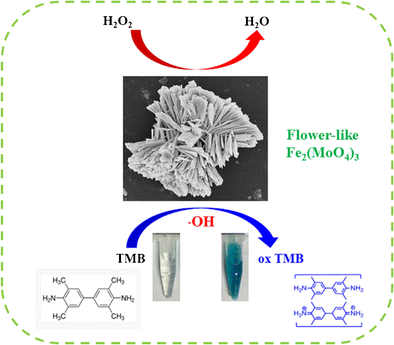Abstract: The authors describe the preparation of Fe2(MoO4)3 materials with micrometer dimensions, and show that they are highly efficient peroxidase mimics that can be used in a photometric assay for H2O2. Depending on the experimental conditions of synthesis, the Fe2(MoO4)3 micromaterials display different morphologies, surface properties, and peroxidase-like activities. Among them, Fe2(MoO4)(3) with flower-like structure has the largest BET specific surface area and the most negative potential. It exhibits the best peroxidase mimetic activity in catalyzing the oxidation of 3,3',5,5'-tetramethylbenzidine in the presence of H2O2 to generate a blue-green product. Based on these findings, method was worked out for H2O2 determination that allows both visual and photometric read-out. The assay has a detection limit as low as 0.7 mu M, is selective and practical. Given its sensitivity, the method has a good potential with respect to determination of H2O2 in clinical samples but also in oxidase-type of reactions where H2O2 is being produced. KeyWords Plus: HYDROGEN-PEROXIDE; HORSERADISH-PEROXIDASE; GLUCOSE DETECTION; GRAPHENE OXIDE; NANOPARTICLES; MIMETICS; NANOCOMPOSITE; CHOLESTEROL; NANOSPHERES; OXIDATION Published in MICROCHIMICA ACTA, 183 (11):3025-3033; 10.1007/s00604-016-1955-8 NOV 2016
|
